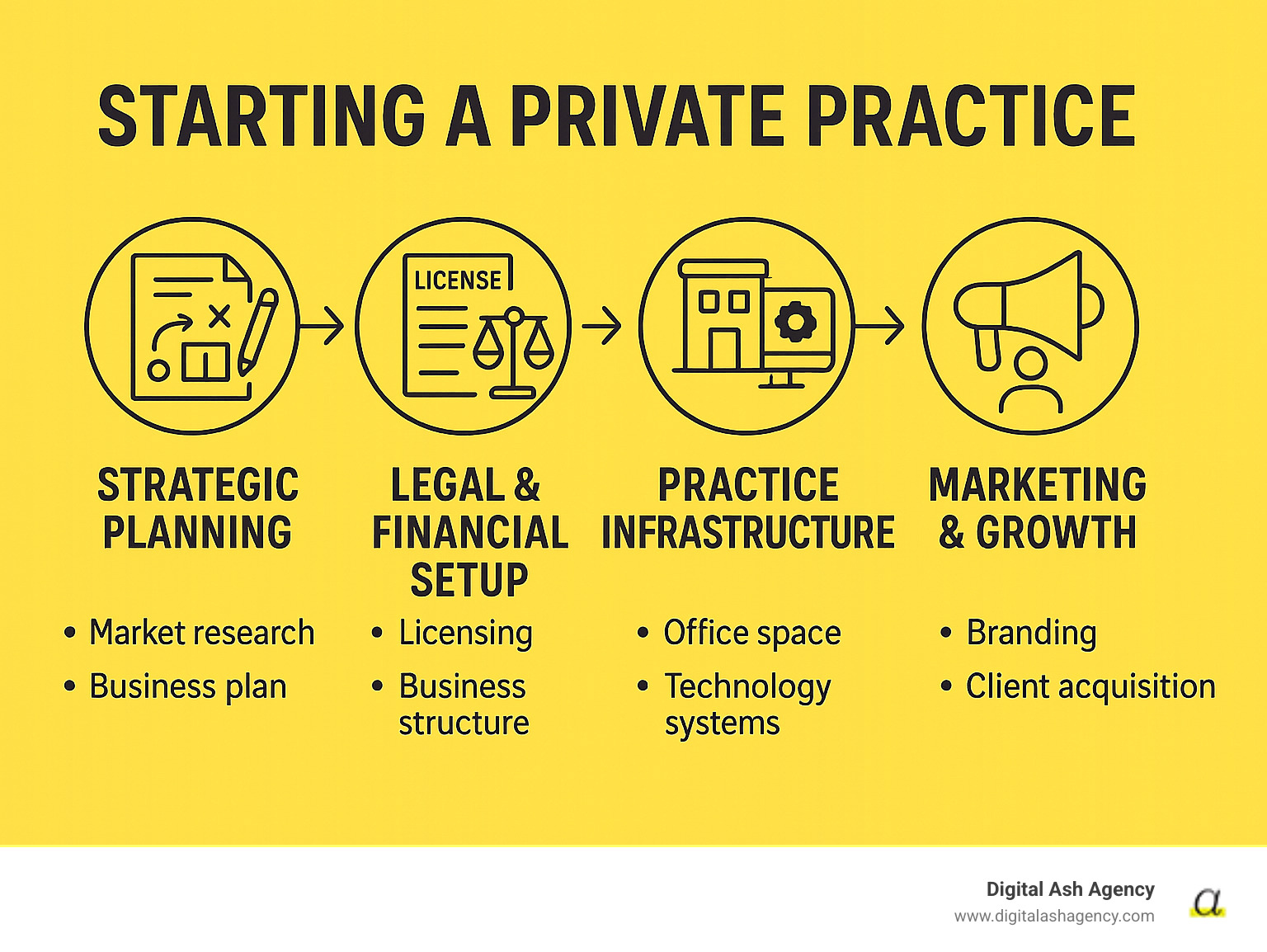
Why Starting a Private Practice is the Path to Clinical Freedom
Starting a private practice is the ultimate goal for many healthcare professionals seeking clinical autonomy and professional fulfillment. The landscape has evolved, with over half of psychologists now in independent practice, but this path requires navigating new challenges from regulations to marketing.
Essential Steps to Launch Your Practice:
- Strategic Planning: Define your vision, research your market, and create a solid business plan.
- Legal & Financial Setup: Choose a business structure, get licensed, and set up banking and insurance.
- Practice Infrastructure: Secure office space, implement technology, and ensure compliance.
- Marketing & Growth: Build your brand, establish referral networks, and attract ideal clients.
The dream of owning a practice is achievable, but it demands both clinical skill and business acumen. You'll need to understand everything from HIPAA compliance to financial planning. The good news is that it typically takes two to three years to build a full practice, and the journey is incredibly rewarding.
This guide provides a step-by-step roadmap to transform your clinical expertise into a thriving business, even in saturated markets or while navigating non-compete agreements.
I'm Ashley Gay, a branding expert specializing in helping healthcare professionals build successful practices. My husband's practice achieved nearly $1 million in its first year by using strategic marketing designed for starting a private practice. I've helped hundreds of practitioners make the journey from employee to successful business owner.

Step 1: Laying the Groundwork - Strategic and Business Planning

Before you buy office furniture, the most important step in starting a private practice is strategic planning. First, clarify your "why." Are you seeking clinical autonomy, better work-life balance, or to fulfill an entrepreneurial spirit? Your motivation is the foundation that will sustain you through challenges.
Next, conduct market research to understand your community's needs. Examine population needs to find underserved groups. For example, many U.S. communities have a shortage of child and adolescent therapists. Then, perform a competitor analysis to find gaps in the market and ways to differentiate your practice. Look at what services are saturated, what populations are overlooked, and what existing practices charge.
This research leads to niche development. Trying to be everything to everyone makes you invisible. Specialization is your secret weapon. Focusing on a specific area, like executives with workplace stress or new mothers with postpartum challenges, helps you attract your ideal clients and charge premium rates. Develop a detailed ideal client profile that goes beyond demographics to understand their struggles and where they seek help.
With your vision clear, it's time to create your roadmap. A solid business plan is your roadmap that turns your vision into actionable steps. This living document helps you anticipate challenges and stay focused.
Key components of a private practice business plan include:
- Executive Summary: A one-page overview of your mission and goals.
- Practice Description: Your unique services and what sets you apart.
- Market Analysis: Research on clients, competitors, and local trends.
- Organizational Structure: Your legal setup and future staffing plans.
- Services and Operations: The client experience from start to finish.
- Marketing and Branding Strategy: How you'll attract and retain clients.
- Budget and Financial Planning: Startup costs, pricing, and projections.
- Risk Analysis: Identifying potential pitfalls and mitigation plans.
- Action Plan: A launch timeline with specific, manageable steps.
- Exit Plan: Your long-term vision for expansion, sale, or retirement.
This planning phase is the difference between a practice that thrives and one that struggles. Taking the time to build a strong foundation makes everything that follows easier.
Step 2: The Nuts and Bolts of Starting a Private Practice

This section covers the administrative setup for starting a private practice. Think of it as building the foundation of your dream house; get it right, and everything else is easier.
Legal and Regulatory Requirements
First, establish the legal framework to protect you and your practice.
- Choose a business structure: A sole proprietorship is simple but offers no personal asset protection. An LLC (Limited Liability Company) creates a crucial separation between personal and business finances. An S-Corporation can offer tax advantages but is more complex. Some states also offer PLLCs (Professional Limited Liability Companies) for licensed professionals. Consult a small business attorney or CPA to choose the right structure for you.
- Licensing and Registration: Ensure your professional license is solid. Requirements vary by state but typically include an accredited graduate degree, supervised hours, and passing exams like the National Counselor Examination. Start this process early, as it can take months. For business registration, get an Employer Identification Number (EIN) from the IRS for taxes and banking. You'll also need a National Provider Identifier (NPI) for billing and HIPAA transactions. You can get your NPI number here.
- Compliance: HIPAA is the law. You must protect client privacy and data. This involves using informed consent forms, HIPAA notices, and secure procedures for handling protected health information. The NASW HIPAA toolkit is a useful resource, but having a healthcare attorney review your documents is a wise investment.
Key Financial Considerations When Starting a Private Practice
Starting a private practice can be surprisingly affordable. Many practitioners launch with minimal investment, sometimes by starting as a side hustle while maintaining another job to ensure financial stability.
- Business Banking: You must separate personal and business finances. Open dedicated checking, savings, and credit card accounts for your practice to protect your personal assets and simplify tax preparation.
- Pricing Your Services: Decide between private pay and insurance contracting. Private pay offers higher fees and more autonomy, while insurance provides a larger client pool but involves lower reimbursement rates and more administrative work. Many practices use a hybrid model, offering superbills for out-of-network reimbursement while selectively joining insurance panels. If you work with insurance, be prepared for payer contracting complexities; resources like Payor Contracting 101 can help.
- Billing and Taxes: Implement efficient systems for billing from day one. The AMA resources on claims submission offer valuable guidance. As a business owner, you'll pay quarterly estimated taxes. Setting aside 20-35% of your income is a common practice. A CPA can help you maximize deductions and stay compliant.
Essential Insurance for Your Practice
Insurance is your practice's safety net. Work with an agent who understands healthcare to build a comprehensive plan.
- Professional Liability Insurance: Also called malpractice coverage, this is essential to protect you against claims of professional errors.
- General Liability Insurance: Covers physical incidents, like a client slipping in your office.
- Business Overhead Insurance: Covers business expenses if you become disabled and unable to work.
- Cybersecurity Insurance: Protects against data breaches and cyberattacks.
- Workers' Compensation: Required if you hire employees, it covers on-the-job injuries.
- Property Insurance: Protects your office space and its contents from damage or theft.
Step 3: Creating Your Practice Environment - From Office Space to Technology

With the legal and financial foundations set, it's time to build the physical and digital infrastructure for your practice.
Physical vs. Virtual Practice Setup
One of your first logistical decisions is where you'll see clients.
- Office Space: Many new practitioners start by subletting space to minimize overhead before committing to a full lease or purchase. A home office can be cost-effective for telehealth but must be private, professional, and soundproof. When selecting a location, consider client accessibility and local market demand. If you have a physical office, create a welcoming and comfortable design with good lighting and soundproofing to ensure confidentiality.
- Telehealth Practice: Telehealth offers immense flexibility and expands your reach. You must use HIPAA-compliant platforms to ensure client privacy. A professional background, good lighting, and a reliable high-speed internet connection are essential for effective virtual sessions.
Essential Equipment and Technology
Technology is the backbone of a modern practice, streamlining operations and ensuring compliance.
- Practice Management Software (PMS): This is a necessity. A good PMS integrates critical functions like EHR/EMR for secure client records, scheduling, billing, and a client portal for secure communication and forms. Investing in a reliable PMS saves countless administrative hours.
- Office Equipment: You'll need a reliable computer, a printer (though many practices aim to be paperless), and a dedicated business phone system. Your phone service must be HIPAA-compliant to protect client privacy.
- Medical Supplies: Depending on your specialty, you may need specific supplies. AMA members can access discounts on over 300,000 medical products through the AMA Medline Buying Program.
- Secure Communication: Use HIPAA-compliant email for any client-related communications outside of your PMS to protect sensitive information.
Step 4: Growing Your Practice - Marketing, Networking, and Client Acquisition

Now that your foundation is built, it's time to attract the right clients. Starting a private practice requires effective marketing to ensure your ideal clients can find you.
Building Your Brand and Online Presence
Your brand is your practice's personality. Choose a memorable practice name, design a professional logo, and write a clear mission statement. Your professional website is your virtual storefront and often a client's first impression. To ensure potential clients can find you online, you must learn and implement SEO. Using SEO for therapists, especially local SEO, helps your practice appear in relevant searches. Industry standards suggest that about half of new clients come from online sources, highlighting the importance of a strong digital presence. Blogging on topics in your specialty and listing your practice in online directories can further boost your visibility and establish you as an authority.
Essential Marketing Strategies for Starting a Private Practice
Proactive marketing and networking are key to filling your caseload. Build referral sources by connecting with physicians, other healthcare providers, schools, lawyers, and other therapists. Engage in professional networking by attending conferences and joining local associations to expand your referral network. Don't underestimate community involvement; giving free talks or workshops can showcase your expertise and connect you directly with potential clients. For those in competitive markets or navigating non-compete agreements, specialized support can be invaluable. We at Digital Ash Agency offer marketing and networking strategies to help new practices establish a strong foundation.
Enhancing the Patient Experience for Long-Term Success
Attracting clients is the first step; retaining them is crucial for long-term success. A positive patient experience builds loyalty and encourages word-of-mouth referrals. Intentionally design the client journey by building a patient experience program, from the first contact through ongoing care. Client retention relies on strong therapeutic rapport and high-quality care. Finally, prioritize self-care to manage burnout. Set healthy boundaries, engage in regular peer consultation, and remember that the battle against burnout is ongoing. Your well-being is essential for a sustainable practice.
Frequently Asked Questions about Starting a Private Practice
Let's tackle some of the most common questions that arise when starting a private practice.
How long does it take to build a full private practice?
It's a marathon, not a sprint. The general consensus is that it takes about two to three years to build a full private practice. The timeline can be influenced by several factors, including:
- A specialized niche: An in-demand specialty can attract clients faster.
- Marketing efforts: Consistent and smart marketing accelerates growth.
- Location: An underserved area may fill up quicker than a saturated market.
- Referral networks: Strong professional connections are a game-changer.
Patience, perseverance, and a solid financial plan to support you during the growth phase are essential.
Should I accept insurance or be private pay only?
This is a major decision, and many practitioners choose a hybrid model to balance the pros and cons.
- Insurance-Based Practice:
- Pros: Access to a larger, more diverse client pool.
- Cons: Lower per-session rates, significant administrative burden, delayed payments, and potential for audits. Trends in Payor Audits show that preparation is crucial.
- Private Pay Practice:
- Pros: Higher per-session rates, minimal paperwork, and full autonomy over treatment and fees.
- Cons: A potentially smaller client pool, often limited to those who can afford to pay out-of-pocket.
A hybrid approach, where you accept some insurance plans while also offering private pay options or superbills, can provide both financial stability and clinical freedom.
What are the most common mistakes to avoid when starting a private practice?
Being aware of common pitfalls can help you steer clear of them. Here are some key mistakes to avoid:
- Underestimating startup costs: Budget for legal fees, marketing, and operational expenses from the start to avoid financial stress.
- Neglecting business planning: Your clinical skills are essential, but they aren't enough. A solid business plan is your roadmap to success.
- Doing everything yourself: Don't hesitate to seek professional advice from lawyers, accountants, and mentors. Their expertise can save you time, money, and future headaches.
- Poor marketing: The "if you build it, they will come" approach doesn't work. You must actively market your services online and through networking to attract clients.
- Ignoring self-care: The demands of being a clinician and business owner can lead to burnout. Set clear boundaries and prioritize your well-being for long-term sustainability.
Conclusion: Your Journey to a Thriving Practice
Starting a private practice is a significant undertaking, blending your clinical passion with the business acumen needed to make your dream a reality. We've walked through the essential steps, from strategic planning and legal setup to marketing and client care. You now have a comprehensive roadmap to not just start, but succeed.
Building a thriving practice is a long game that requires a clear vision, adaptability, and a commitment to continuous learning. As even the AMA recognizes in courses like its Introduction to the Business of Medicine, it's an ongoing process of growth.
At Digital Ash Agency, we understand this unique path. We specialize in marketing and networking strategies for healthcare practices, helping you build crucial relationships and thrive, even in competitive markets or while navigating non-compete agreements.
Are you ready to build the practice of your dreams? We're passionate about helping new practices establish a strong, sustainable foundation. Let's make your vision a reality.







